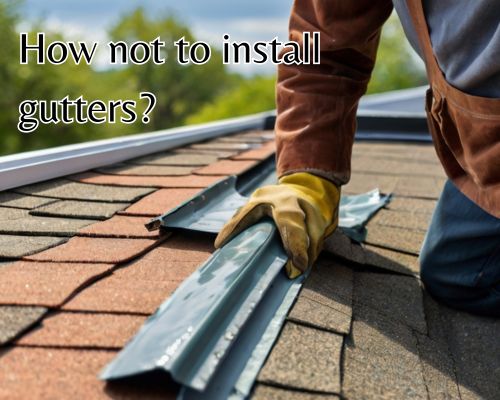- July 31, 2025
- By Rebecca Washington
- Uncategorized
How Not to Install Gutters: Common Mistakes to Avoid in West Palm Beach, Florida
Introduction: Why Knowing How Not to Install Gutters Matters
In sunny, storm-prone West Palm Beach, Florida, where rainfall and tropical storms are regular visitors, rain gutters are more than a structural accessory—they’re essential. Whether you’re a DIY enthusiast or hiring a local contractor, understanding how not to install gutters is just as important as knowing how to do it right. Incorrect installation can lead to serious issues such as water damage, mold growth, erosion, and even foundation damage.

With Mike Owen of Gutters of West Palm Beach, we’ll cover the top gutter installation mistakes, discuss why they’re dangerous, and help homeowners in West Palm Beach avoid costly repairs. You’ll learn what to look out for and which red flags to avoid to ensure your rainwater drainage system works optimally in Florida’s unique subtropical climate.
1. Ignoring the Pitch (Slope) of the Gutter
One of the most common mistakes in gutter installation is assuming the system should be perfectly level. Nope. Gutters require a slight slope—usually about 1/4 inch per 10 feet—toward the downspout. A level gutter means water pools and doesn’t drain efficiently, leading to overflow and sagging.
In West Palm Beach, where heavy downpours can occur in minutes, an improperly pitched gutter will fail almost immediately. Standing water also invites mosquitoes, which are already a nuisance in South Florida.
🔎 Local Insight: Many homes in areas like Flamingo Park and El Cid deal with landscaping challenges, and improper gutter slope can worsen soil erosion and damage the roots of palm and ficus trees.
2. Spacing Gutter Hangers Too Far Apart
Gutter hangers are brackets that support the entire system. Installing them too far apart—say, more than 36 inches—can cause the gutter to sag or pull away from the fascia board. In West Palm Beach’s humid climate, moisture damage and UV degradation from intense sunlight can weaken materials faster than in cooler regions.
Over time, sagging gutters become breeding grounds for algae and mildew, creating both a functional and aesthetic nightmare.
Pro Tip: Use stainless steel or aluminum hidden hangers every 24 to 30 inches, especially in coastal areas like Palm Beach Shores or Riviera Beach where salt air accelerates corrosion.
3. Incorrect Downspout Placement or Quantity
Another rookie mistake? Assuming one downspout is enough. Or worse—installing it in the wrong place.
What happens when gutters can’t drain fast enough? Water backs up, spills over, and seeps into the fascia, siding, and foundation. West Palm Beach homes, especially older ones in historic neighborhoods, often have unique rooflines that require multiple, strategically placed downspouts.
🧠 Think Ahead: Always evaluate the roof size and pitch. A 2,000 sq ft roof collecting 1 inch of rain will yield over 1,200 gallons of runoff. Without enough downspouts, all that water ends up in the wrong places.
4. Using the Wrong Materials for the Coastal Climate
Florida is rough on construction materials. Gutters made of vinyl or thin galvanized steel don’t last long in the salt-heavy air of coastal West Palm Beach. They crack, warp, and rust prematurely.
🚫 Avoid This: Opt for corrosion-resistant materials like aluminum, copper, or marine-grade stainless steel. Seamless aluminum gutters are popular in the region due to their longevity, resistance to rust, and sleek aesthetic.
🔗 LSI Keywords to Note: “seamless gutters,” “aluminum gutters West Palm Beach,” “rust-resistant gutter materials,” “coastal gutter protection,” “tropical weather gutters”
5. Neglecting to Use Proper Sealants or Gutter Guards
Improper sealing or the absence of gutter guards invites leaks and clogs—two enemies of a well-functioning gutter system. In Florida, where debris from tropical plants like royal palms and oaks litters rooftops, clogged gutters become mini-swamps.
🛠️ What to Avoid:
- Not sealing gutter joints with UV-resistant sealant.
- Failing to install gutter guards to reduce maintenance.
- Using mesh guards that corrode quickly in salt air.
🏝️ In Palm Beach Lakes and Northwood Hills, homeowners are increasingly installing micro-mesh aluminum guards to minimize maintenance during hurricane season.
6. Forgetting About Fascia and Soffit Integrity
A structurally compromised fascia or soffit won’t support a gutter system for long. Unfortunately, some installers skip inspecting or reinforcing these areas.
When water penetrates soft wood fascia—especially on older homes in areas like Southland Park—it can lead to rot, termite infestation, and roof damage.
💡 West Palm Beach Tip: Always replace or reinforce rotten fascia boards with treated wood or PVC composites before installation. Look for signs of damage like peeling paint, soft spots, or sagging boards.
7. Overlooking Local Codes and HOA Guidelines
West Palm Beach has zoning regulations and HOA restrictions, especially in planned communities like Ibis or CityPlace. Ignoring these can lead to fines—or worse, having to redo the work.
🏛️ Local LSI Mentions:
- “West Palm Beach building codes”
- “Palm Beach County gutter permits”
- “HOA-approved gutter colors”
- “Hurricane-proof gutter standards”
🌀 Hurricane Tip: Gutters should be secured with screws, not nails, to meet local wind-resistance guidelines. Consider adding splash blocks or French drains to handle overflow during tropical storms.
8. Improper Gutter Size Selection
Some folks think all gutters are created equal. But 5-inch K-style gutters are not ideal for larger roofs or steep slopes—common features in West Palm Beach architecture.
🌧️ Wrong size = wrong result:
- Small gutters overflow frequently.
- Large gutters, if installed improperly, pull away from the fascia.
🌴 Pro Insight: Use 6-inch seamless aluminum K-style gutters for most Florida homes, and upgrade to commercial-grade 7-inch options for multi-level structures or those with extensive roofline runoff.
9. Failing to Account for Landscaping Drainage
Water spilling from the gutters can wreck your landscape if it’s not guided away from the foundation. In low-lying areas like Golden Lakes, poor gutter design can result in swampy yards and mosquito-infested zones.
🧭 Avoid These Errors:
- No splash blocks or drain tile extensions.
- Letting downspouts terminate near flower beds or walkways.
- Not using underground drainage pipes where needed.
💧 Better Solution: Direct downspouts into buried PVC drainage that funnels water away at least 10 feet from the home.
10. DIYing Without a Safety Plan or Experience
Lastly, while it’s tempting to tackle gutter installation solo, West Palm Beach roofs are often steep and slick with mildew or algae. A misstep can be life-threatening.
🏚️ Don’t do this:
- Using unstable ladders on soft ground.
- Skipping safety harnesses.
- Cutting corners on flashing and drip edge placement.
🧰 Local Tip: Hire licensed contractors like Gutters of West Palm Beach who understand the regional weather, HOA expectations, and gutter load requirements.
Conclusion: Avoiding Mistakes Pays Off
Knowing how not to install gutters is just as valuable as a step-by-step guide—maybe even more so in West Palm Beach, Florida, where weather extremes meet architectural variety.
From choosing the right materials to correctly sloping your gutters and following local codes, every decision impacts your home’s protection and curb appeal. Avoid these common mistakes, and you’ll ensure your gutter system doesn’t just look good—it works flawlessly.




